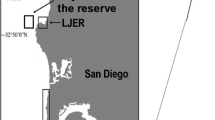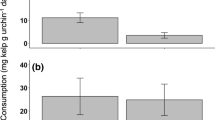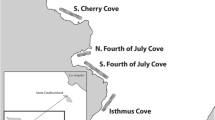Summary
At two stations in the San Onofre kelp bed near San Clemente, California the abundance of sea urchins, Lytechinus anamesus, and starfish, Patiria miniata, were negatively correlated. At one station, urchins were more abundant outside compared to inside the kelp bed, a pattern which generally occurs in southern California. In contrast, at the other station urchins were more abundant inside the bed. This exception to the general rule indicates that the distributions were not simply determined by something associated with the presence of kelp. Samples of substrates, sea urchins and sea stars suggested that the distribution of Patiria but not Lytechinus was controlled by the availability of suitable substrates. Further experiments showed that: 1) Patiria elicit an escape response from Lytechinus, the strength of which is positively related to the size of the urchins, 2) small urchins, which react less strongly to Patiria, are preyed on more heavily than are larger ones, and 3) escape responses elicited by Patiria cause local reductions of Lytechinus in the field. We conclude from these results that predation by Patiria controls the distribution of Lytechinus at our study sites, and may account for this species distribution in kelp forests throughout southern California. The possible effects of this predator-prey interaction on the structure of kelp forest communities are discussed.
Similar content being viewed by others
Refereces
Araki GS (1964) On the physiology of feeding and digestion in the sea star Patiria miniata Ph.D. Thesis, Stanford University
Birkeland C (1974) Interactions between a sea pen and seven of its predators. Ecol Monogr 54:211–232
Day RW, Osman RW (1981) Predation by Patiria miniata (Asteroidea) on bryozoans: prey diversity may depend on the mechanism of succession. Oecologia (Berl) 51:300–309
Dayton, PK (1971) Competition, disturbance, and community organization: the provision and subsequent utilization of space in a rocky intertidal community. Ecol Monogr 41:351–389
Dayton PK (1978) Two cases of resource partitioning in an intertidal communitiy: making the right prediction for the wrong reason. Am Nat 107:662–670
Dayton PK, Robilliard GA, Paine RT, Dayton LB (1974) Biological accomodation in the benthic community at McMurdo Sound, Antarctica. Ecol Monogr 44:105–128
Dayton PK, Rosenthal RJ, Mahen LC, Antezana T (1977) Population structure and foraging behavior of the predaceous Chilean asteroid Meyenaster gelatinosus and the escape behavior of its prey. Mar Biol 39:361–370
Dean TA, Dixon J, Schroeter SC (1982) Effects of two species of sea urchins on populations of kelp. In prep.
Dixon JD (1978) Determinants of the local distribution of four closely-related species of herbivorous marine snails. Ph.D. Thesis Univ California, Santa Barbara
Fawcett MH (1979) The consequences of latitudinal variation for some marine intertidal herbivores. Ph.D. Thesis Univ California, Santa Barbara
Feder HM (1980) Asteroidea: the sea stars. In: RH Morris, DP Abbott and C Haderlie (eds), Intertidal Invertebrates of California Stanford Univ Press, Stanford, Calif, p 117–135
Gerard VA (1976) Some aspects of material dynamics and energy flow in a kelp forest in Monterey Bay, California. Ph.D. Thesis, Univ California, Santa Cruz
Kastendiek J (1982) Factors determining the distribution of the sea pansy, Renilla kollikeri, in a subtidal sand-bottom habitat. Oecologia (Berl) 52:340–347
Keough MJ, Butler AJ (1979) The role of asteroid predation in the organization of a sessile community on pier pilings. Mar Biol 51:167–177
Landenberger DE (1967) A study of predation and predatory behavior in the Pacific starfish, Pisaster. Ph.D. Thesis, Univ California, Santa Barbara
Lubchenco J, Menge BA (1978) Community development and persistence in a low rocky intertidal zone. Ecol Monogr 59:67–94
Mauzey, KP, Birkeland C, Dayton PK (1968) Feeding behavior of asteroids and escape responses of their prey in the Puget Sound region. Ecology 49:603–619
North WJ (1965) Point Loma. Ann. Rpt. Kelp Habitat Improvement Project, 1 Feb 1964–31 March 1965, Calif Inst Tech, p 6–24
North WJ ed. (1971) The biology of giant kelp beds (Macrocystis) in California. Nova Hedwigia 32:1–600
Paine RT (1966) Food web complexity and species diversity. Am Nat 100:65–75
Paine RT (1969) The Pisaster-Tegula interaction: prey patches, predator food preferences and intertidal community structure. Ecology 52:136–141
Paine RT (1974) Intertidal community structure. Experimental studies on the relationship between a dominant competitor and its principal predator. Oecologia (Berl) 15:93–120
Paine RT, Vadas RL (1969) The effects of grazing by sea urchins, Strongylocentrotus spp., on benthic algal populations. Limnol Oceanogr 14:710–719
Pearse JS, Clark ME, Leighton DL, Mitchell CT, North WJ (1970) Size structure of urchin populations. Appendix to Ann Rpt. Kelp Habitat Improvement Project, 1969–1970, Calif Inst Tech, p 51–87
Peterson CH (1979) The importance of predation and competition in organizing the intertidal epifaunal communities of Barnegat Inlet, New Jersey. Oecologia (Berl) 39:1–24
Peterson CH, Bradley BP (1978) Estimating the diet of a sluggish predator from field observations. J Fish Res Board Can 35:136–141
Phillips DW (1976) The effect of a species-specific response to predatory starfish on the intertidal distribution of two gastropods. Oecologia (Berl) 23:83–94
Rosenthal RJ (1971) Trophic interaction between the sea star Pisaster giganteus and the gastropod Kelletia kelletii. Fish Bull 69:669–679
Rosenthal RJ, Chess JB (1972) A predator-prey relationship between the leather star, Dermasterias imbricata, and the purple sea urchin, Strongylocentrotus purpuratus. Fish Bull 70:205–216
Rosenthal RJ, Clarke WD, Dayton PK (1974) Ecology and natural history of a stand of giant kelp, Macrocystis pyrifera, off Del Mar, California. Fish. Bull 72:670–684
Schmitt RJ (1981) Contrasting anti-predator defenses of sympatric marine gastropods (Family Trochidae). J exp Mar Biol Ecol 54:251–263
Schmitt RJ (1982) Consequences of dissimilar defenses against predation in a subtidal marine community. Ecology 63:1588–1601
Author information
Authors and Affiliations
Rights and permissions
About this article
Cite this article
Schroeter, S.C., Dixon, J. & Kastendiek, J. Effects of the starfish Patiria miniata on the distribution of the sea urchin Lytechinus anamesus in a southern Californian kelp forest. Oecologia 56, 141–147 (1983). https://doi.org/10.1007/BF00379683
Received:
Issue Date:
DOI: https://doi.org/10.1007/BF00379683




